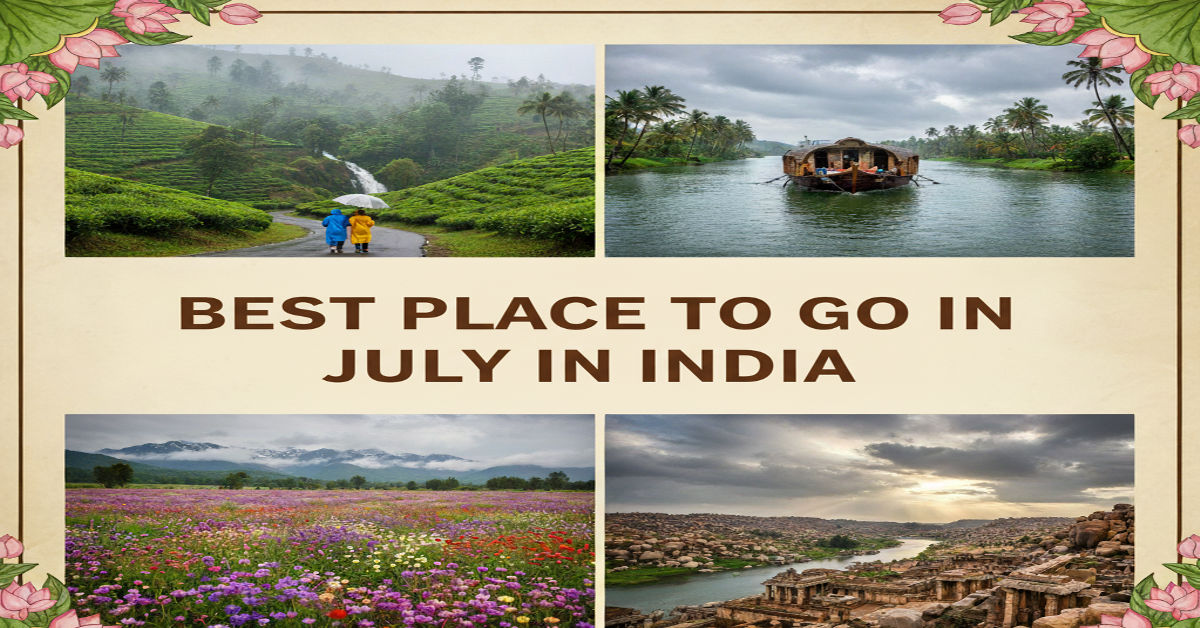July in India unfolds like a painter’s canvas washed in green. The monsoon season breathes life into rivers, forests and fields, transforming landscapes into living art. Far from being a time to stay indoors, July invites travelers to explore a quieter more authentic India where nature thrives and crowds thin out. Misty mountains, sparkling lakes and rain-soaked paths reveal a beauty unseen in drier months.
For those seeking the best place to go in July in India the monsoon opens doors to destinations rich in charm and culture. From the dry plateaus of Ladakh to the flower-filled meadows of Uttarakhand every region offers something unique. Traveling in July means embracing unpredictability with joy—listening to rain on the roof while sipping chai, wandering through cloud-kissed valleys, and finding stories where few travelers venture.
Understanding the July Landscape Across India
India’s vast geography makes July an adventure in contrasts. The southwest monsoon brings heavy rain to coastal belts and plains, yet parts of the north and west remain almost dry. This diversity allows travelers to choose between lush greenery and arid calm. While Kerala glistens under warm showers, Ladakh’s skies stay sapphire blue.
Regions like Himachal Pradesh and Uttarakhand offer cooler escapes where the rain accentuates the mountain beauty. On the other hand, Rajasthan and Spiti Valley lie in rain shadows, providing clear roads and sunshine. According to Rough Guides, these micro-climates make July a rewarding yet underrated month for travel. The key is matching your travel style—quiet retreats, outdoor adventure, or cultural immersion—to the region that suits July’s rhythm.
How to Choose the Perfect July Destination
Selecting the right destination in July means balancing thrill with practicality. The best place to go in July in India should offer accessibility, safe weather, and meaningful experiences. Rain can both enrich and challenge your journey, so it’s essential to plan smartly.
| Criteria | Why It Matters in July | Ideal Example |
| Rainfall | Too much can disrupt travel, too little dulls the view | Ladakh, Spiti Valley |
| Accessibility | Road safety and open routes are crucial | Rajasthan, Uttarakhand |
| Natural Appeal | Monsoon brings lushness and waterfalls | Kerala, Meghalaya |
| Cultural Richness | Festivals and local life thrive in monsoon | Udaipur, Coorg |
| Adventure Potential | Trekking, biking, photography | Ladakh, Valley of Flowers |
When you align your goals with these factors, the journey feels effortless. As National Geographic Travel notes, India’s monsoon isn’t an obstacle—it’s an opportunity to see the country breathe.
Ladakh: The Crown Jewel of July Travel
Ladakh, in northernmost India, is a haven untouched by the monsoon. While the rest of the nation drinks from endless rain, Ladakh enjoys clear skies and crisp mountain air. Its golden deserts and turquoise lakes create a surreal contrast that photographers dream of capturing. July marks the perfect season—roads from Manali and Srinagar open fully, and festivals begin.
Travelers can explore monasteries perched on cliffs, ride through high passes, or camp beside Pangong Lake under a galaxy of stars. Adventure lovers revel in treks like the Markha Valley trail or biking along Khardung La, one of the world’s highest motorable roads. Compared to humid regions, Ladakh’s dryness is a blessing. Local homestays offer warmth and cultural insight, turning every night’s stay into a story shared over butter tea.
Valley of Flowers: Nature’s Canvas in Bloom
If you believe paradise blooms in monsoon, the Valley of Flowers in Uttarakhand will prove it. Every July, meadows here explode into color as alpine flowers bloom across hillsides. The air carries fragrance and mist, and every trek feels like walking through a living poem. This UNESCO World Heritage Site stays open from June to early October, with July marking its floral peak.
Reaching the valley is a rewarding journey: a scenic drive from Rishikesh, followed by a trek from Govindghat to Ghangaria, then into the valley. It’s challenging yet profoundly healing. Trekkers often combine it with Hemkund Sahib, a sacred high-altitude lake. For those wanting more insight into eco-travel, Rubble Magazine’s sustainable tourism features provide thoughtful perspectives on preserving such fragile beauty while enjoying it responsibly.
Spiti Valley: The Quiet Twin of Ladakh
Spiti Valley, often called Ladakh’s quieter sibling, sits high in Himachal Pradesh’s Trans-Himalayan region. Shielded from monsoon rains by mountain walls, it remains accessible and spectacular through July. Its raw beauty—turquoise rivers, stark ridges, and centuries-old monasteries—makes it one of India’s most photogenic valleys.
Unlike Ladakh’s more touristy spots, Spiti retains a serene isolation. You can visit ancient monasteries at Key, Tabo, or Dhankar, trek to Chandratal Lake, or live among local families in remote villages. The roads challenge even seasoned travelers, but the reward is silence and star-filled skies. Local guesthouses welcome visitors warmly, offering insight into Buddhist culture. Travel reports on Travel Triangle praise Spiti as an unfiltered encounter with the Himalayas.
Kerala: Monsoon Symphony of the South
Kerala becomes a masterpiece of green during July. The monsoon cloaks its backwaters, hills, and beaches in a gentle sheen, creating a serene atmosphere for introspection and leisure. Many travelers visit specifically for Ayurvedic therapies that use this humid season to detoxify and heal the body. The rain here feels soft and rhythmic, not harsh or disruptive.
Houseboats glide through quiet canals in Alleppey while tea estates in Munnar shimmer with raindrops. Local festivals and Kathakali performances bring color to grey skies. Though outdoor plans may shift, Kerala’s charm lies in slowing down. Every rainfall feels like a reminder to pause and breathe. As EaseMyTrip notes, Kerala’s monsoon tourism has its own loyal following among travelers seeking peace and wellness.
Meghalaya and the Northeast: Embracing the Clouds
Few places celebrate rain as Meghalaya does. Known as the “abode of clouds,” this northeastern state transforms into a world of waterfalls and misty plateaus during July. Cherrapunji and Mawsynram, among the wettest places on earth, reveal landscapes so lush they look unreal. Root bridges woven by hand and hidden caves carved by rivers make it a playground for explorers.
Nearby, Shillong offers colonial charm, music cafés, and lively markets. The drive through the rolling Khasi Hills during monsoon is unforgettable. Even with rain pouring, travelers can trek through living bridges or witness the magnificent Nohkalikai Falls at its mightiest. For cultural depth, combine Meghalaya with Assam or Arunachal Pradesh for a broader view of Northeast India’s diversity.
Rajasthan: The Desert in a New Light
In July, Rajasthan softens. The desert heat begins to ease, and short rains cool the air without drenching the land. Palaces and forts glimmer under monsoon clouds, and the golden dunes near Jaisalmer whisper a cooler wind. Unlike other regions, Rajasthan’s cities remain accessible and vibrant, making it an excellent choice for travelers avoiding heavy rains.
| Destination | Weather in July | Highlights | Travel Tip |
| Udaipur | Pleasant, mild showers | Lakes, palaces, city walks | Visit City Palace after rain for mirrored reflections |
| Jodhpur | Warm but dry | Mehrangarh Fort, blue lanes | Early mornings best for photography |
| Jaisalmer | Hot, minimal rain | Desert safaris | Choose evening camel rides |
| Mount Abu | Cool and misty | Hill views, temples | Great family retreat |
This blend of heritage and comfort makes Rajasthan a sophisticated July choice. The monsoon light turns the desert golden, perfect for slow travel and photography.
Coorg and the Southern Highlands
Coorg, known as the “Scotland of India,” thrives under monsoon drizzle. Rolling coffee estates, hidden waterfalls, and mist-covered hills define its July landscape. The aroma of wet soil and coffee flowers fills the air, creating an immersive sensory experience. Streams swell and wildlife sightings increase in sanctuaries like Nagarhole and Pushpagiri.
Coorg’s appeal lies in its quiet rhythm—morning walks through plantations, local Kodava cuisine, and evenings near crackling fireplaces. Resorts here specialize in cozy monsoon retreats where you can watch rain drift over valleys. For travelers who prefer gentle adventure, Coorg balances nature and comfort gracefully. The region also links well with Mysuru or Wayanad for extended circuits.
Ooty and Kodaikanal: South India’s Misty Escapes
Ooty and Kodaikanal offer cool relief from heat and humidity. In July, mists blanket their slopes while lakes shimmer with rain-fed water. The soft drizzle brings out the fragrance of eucalyptus and pine. Both hill stations provide an easy introduction to monsoon travel without extreme weather challenges.
Boating on Ooty Lake or hiking to Dolphin’s Nose becomes a tranquil experience in this season. Kodaikanal, with its Coaker’s Walk and silver cascades, feels almost dreamlike under clouds. Though showers may interrupt outdoor plans, they also paint an ethereal calm that visitors cherish. Many seasoned travelers return yearly for this monsoon charm that feels far removed from city chaos.
Islands and Coasts: The Monsoon’s Hidden Beauty
July along India’s coastlines reveals a side of the sea few experience. While heavy rain limits water sports, it enhances natural drama. Goa’s beaches turn quiet, yet the countryside blooms with green. Cafés stay open, waterfalls roar, and spice plantations become alive. It’s a time to see Goa’s local life rather than its party face.
Further east, the Andaman Islands demand caution but reward patient travelers. Storm patterns vary, and some beaches remain accessible for diving or trekking. Resorts offer monsoon discounts, and sunsets over the Bay of Bengal carry striking hues. Traveling to these coasts in July is about embracing rhythm over rush, letting tides and rain dictate your pace.
Planning Smart: Tips for July Travel in India
July travel in India rewards those who plan with care Best Place to Go in July in India. Start early each day before showers intensify. Keep flexible schedules and buffer days in case of weather delays. Waterproof bags, light jackets, and quick-dry clothes make a world of difference.
| Travel Aspect | What to Do | Why It Helps |
| Packing | Carry poncho, sturdy shoes, dry bags | Protect gear and comfort |
| Transport | Prefer morning flights or trains | Fewer weather delays |
| Health | Use mosquito repellent, bottled water | Avoid common ailments |
| Local Help | Hire certified guides in hilly regions | Ensures safety and insight |
Traveling responsibly during monsoon also means supporting local tourism. Choose eco-friendly stays and minimize plastic use. The reward is an authentic journey that respects both nature and people.
Conclusion: Finding Your Perfect July Escape
The best place to go in July in India depends on the experience you crave. For adventure and guaranteed good weather, Ladakh and Spiti Valley stand tall. If you seek nature’s bloom, Valley of Flowers and Meghalaya are unmatched. For reflection and rejuvenation, Kerala’s monsoon retreats offer soulful stillness. And if royal heritage calls, Rajasthan’s palaces under gentle rain will answer beautifully.
Wherever you go, July reminds you that India is not just a destination—it’s a mood. The rain doesn’t hinder travel; it transforms it Best Place to Go in July in India. So pack wisely, stay open to surprise, and let the monsoon reveal a side of India seen by only the most curious hearts.
FAQs
1. Which is the safest place to visit in India during July?
Ladakh and Spiti Valley are the safest because they lie in rain-shadow regions with minimal monsoon impact. Their roads and tourist facilities stay operational through July.
2. What are the best family destinations in July?
Coorg, Ooty, and Mount Abu offer mild climates, good hotels, and child-friendly activities. They are great for families seeking peace and natural beauty.
3. Is Kerala worth visiting during heavy monsoon?
Yes. Kerala’s charm multiplies in rain. The backwaters, waterfalls, and Ayurvedic resorts offer a serene experience that’s unique to this season.
4. Can I travel to Goa in July?
You can, but expect rainfall. Goa in July is ideal for slow travelers who enjoy greenery, local markets, and a quiet seaside vibe rather than beach parties.
5. What should I pack for a July trip in India?
Carry waterproof clothing, quick-dry shoes, a raincoat, power bank, and travel insurance. Most importantly, keep flexibility in your itinerary to adapt to changing weather.







